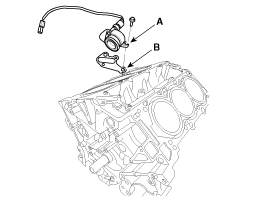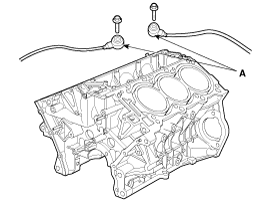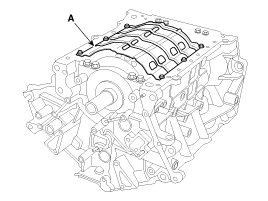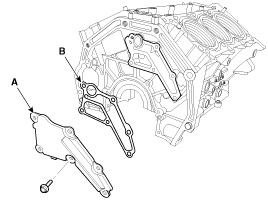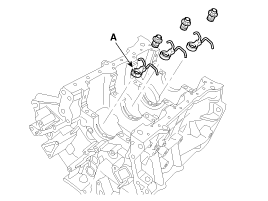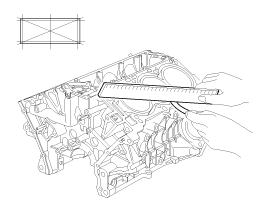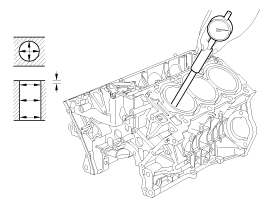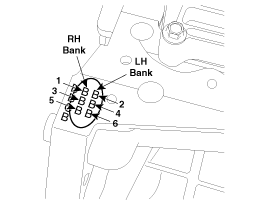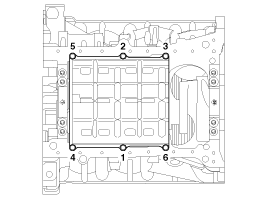 Kia Sedona: Cylinder Block Repair procedures
Kia Sedona: Cylinder Block Repair procedures
Third generation YP (2014-2026) / Kia Sedona YP Service Manual / Engine Mechanical System / Cylinder Block / Cylinder Block Repair procedures
| Disassembly |
|
|
| 1. |
Remove the engine assembly from the vehicle.
(Refer to Engine And Transaxle Assembly - "Engine And Transaxle Assembly") |
| 2. |
Remove the transaxle assembly from the engine assembly.
(Refer to Automatic Transaxle System - "Automatic Transaxle") |
| 3. |
Install the engine assembly to engine stand for disassembly. |
| 4. |
Remove the surge tank.
(Refer to Intake And Exhaust System - "Surge Tank") |
| 5. |
Remove the intake manifold.
(Refer to Intake And Exhaust System - "Intake Manifold") |
| 6. |
Remove the exhaust manifold.
(Refer to Intake And Exhaust System - "Exhaust Manifold") |
| 7. |
Remove the cylinder head assembly.
(Refer to Cylinder Head Assembly - "Cylinder Head") |
| 8. |
Remove the drive plate and adapter plate.
(Refer to Cylinder Block - "Drive Plate") |
| 9. |
Remove the rear oil seal case.
(Refer to Cylinder Block - "Rear Oil Seal") |
| 10. |
Remove the timing chain.
(Refer to Timing System - "Timing Chain") |
| 11. |
Remove the water temperature control assembly.
(Refer to Cooling System - "Water Temperature Control Assembly") |
| 12. |
Remove the lower oil pan and upper oil pan.
(Refer to Lubrication System - "Oil Pan") |
| 13. |
Remove the oil pump.
(Refer to Lubrication System - "Oil Pump") |
| 14. |
Remove the oil filter body.
(Refer to Lubrication System - "Oil filter body") |
| 15. |
Remove the oil cover (A) and gasket (B).
|
| 16. |
Remove the water jacket seperator.
(Refer to Cylinder Block - "Water Jacket Seperator") |
| 17. |
Remove the knock sensor (A).
|
| 18. |
Remove the upper oil pan.
(Refer to Lubrication System - "Oil Pan") |
| 19. |
Remove the baffle plate (A).
|
| 20. |
Remove the oil drain cover (A) and gasket (B).
|
| 21. |
Check the connecting rod end play.
(Refer to Cylinder Block - "Piston and Connecting Rod") |
| 22. |
Check the connecting rod cap oil clearance.
(Refer to Cylinder Block - "Piston and Connecting Rod") |
| 23. |
Remove the piston and connecting rod assemblies.
(Refer to Cylinder Block - "Piston and Connecting Rod") |
| 24. |
Remove the crankshaft main bearing cap and check oil clearance.
(Refer to Cylinder Block - "Crankshaft") |
| 25. |
Check the crankshaft end play.
(Refer to Cylinder Block - "Crankshaft") |
| 26. |
Remove the crankshaft.
(Refer to Cylinder Block - "Crankshaft") |
| 27. |
Remove the oil jets (A).
|
| Inspection |
Cylinder Block
| 1. |
Remove the gasket material.
Using a gasket scraper, remove all the gasket material from the top surface of the cylinder block. |
| 2. |
Clean the cylinder block.
Using a soft brush and solvent, thoroughly clean the cylinder block. |
| 3. |
Inspect the top surface of the cylinder block for flatness.
Using a precision straight edge and feeler gauge, measure the warpage of the surface contacting with the cylinder head gasket.
|
| 4. |
Inspect cylinder bore diameter
Visually check the cylinder for vertical scratches.
If deep scratches are present, replace the cylinder block. |
| 5. |
Inspect cylinder bore diameter
Using a cylinder bore gauge, measure the cylinder bore diameter in the direction of the thrust and axial.
|
| 6. |
Check the cylinder bore size code on the cylinder block.
|
Boring Cylinder
| 1. |
Oversize pistons should be selected according to the largest bore cylinder.
|
| 2. |
Measure the outside diameter of the piston to be used. |
| 3. |
According to the measured O.D (Outer Diameter), calculate the new bore size.
|
| 4. |
Bore each of the cylinders to the calculated size.
|
| 5. |
Hone the cylinders, finishing them to the proper dimension (piston outside diameter + gap with cylinder). |
| 6. |
Check the clearance between the piston and cylinder.
|
| Reassembly |
| 1. |
Install the oil jets (A).
|
| 2. |
Install the crankshaft.
(Refer to Cylinder Block - "Crankshaft") |
| 3. |
Install the crankshaft main bearing cap and check oil clearance.
(Refer to Cylinder Block - "Crankshaft") |
| 4. |
Check the crankshaft end play.
(Refer to Cylinder Block - "Crankshaft") |
| 5. |
Install the piston and connecting rod assemblies.
(Refer to Cylinder Block - "Piston and Connecting Rod") |
| 6. |
Check the connecting rod end play.
(Refer to Cylinder Block - Piston and Connecting Rod") |
| 7. |
Install the oil drain cover (A) with a new gasket (B).
|
| 8. |
Install the baffle plate.
Install and uniformly tighten the baffle plate bolts, in several passes, in the sequence shown.
|
| 9. |
Install the upper oil pan.
(Refer to Lubrication System - "Oil Pan") |
| 10. |
Install the knock sensor (A).
|
| 11. |
Install the water jacket seperator.
(Refer to Cylinder Block - "Water Jacket Seperator") |
| 12. |
Remove the oil cover (A) and gasket (B).
|
| 13. |
Assemble the other parts in the reverse order of disassembly.
|
 Crankshaft Repair procedures
Crankshaft Repair procedures
Disassembly
•
Use fender covers to avoid damaging painted surfaces.
•
To avoid damage, unplug the wiring connectors carefully while holding the con ...
Other Information:
Front side marker
1. Open the hood.
2. Remove the front cover(1) and headlamp assembly nuts(2).
3. Remove the headlamp assembly from the body of the vehicle
4. Remove the socket from the assembly by turning the so ...
Instrument Cluster Description and Operation
Description
Communication Network Diagram
AbbreviationExplanationACUAirbag Control UnitADMAssist Door ModuleB_CANBody Controller Area NetworkBCMBody Control ModuleBSDBlind Spot DetectionC_CANCha ...
Categories
- Home
- First Generation
- Second Generation
- Third generation
- Kia Sedona YP 2014-2026 Owners Manual
- Kia Sedona YP 2014-2026 Service Manual
Copyright © www.kisedona.com 2016-2026



